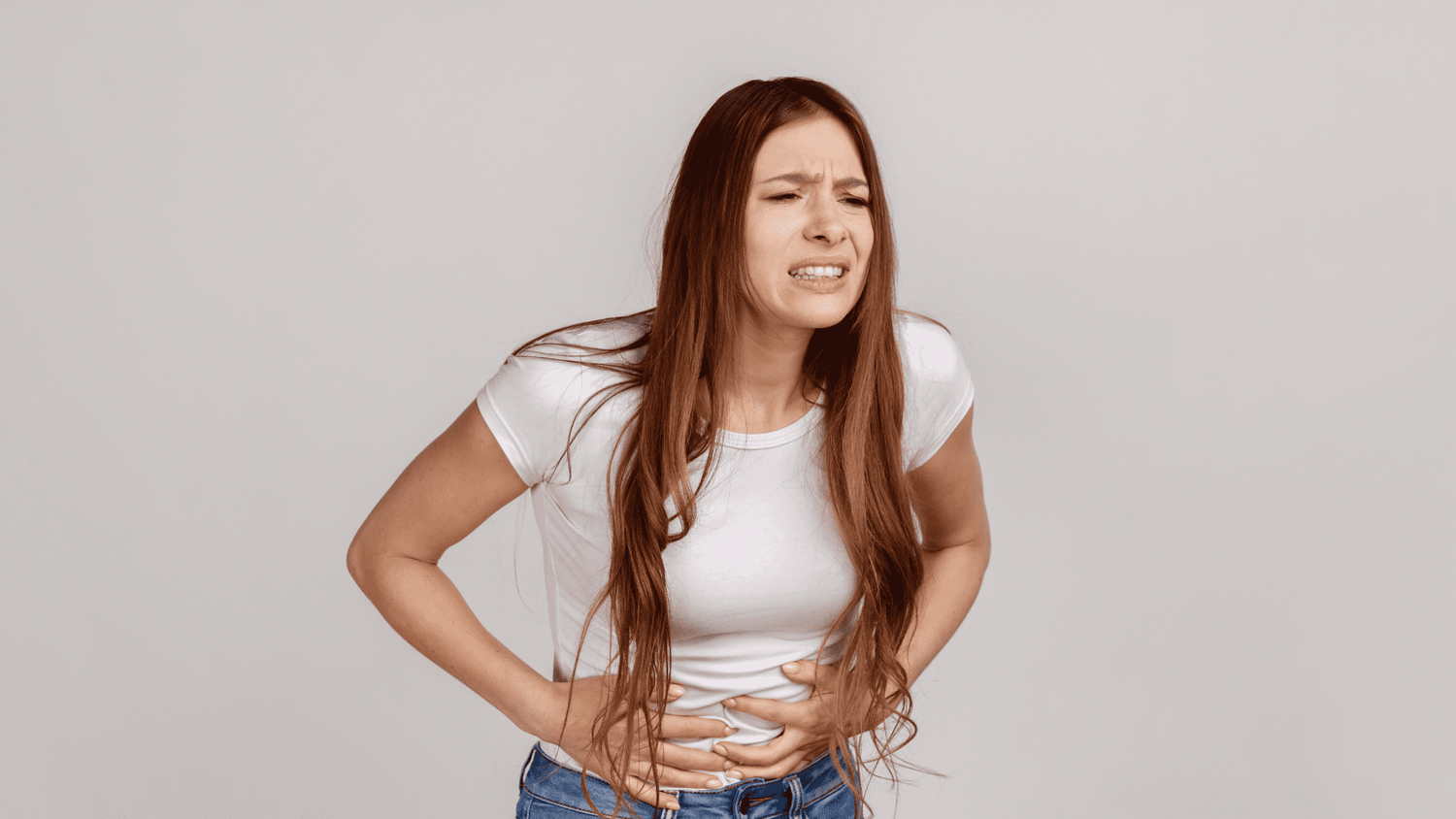Definition and Location
Lower abdominal pain refers to discomfort or pain that occurs in the area between the belly button and the pelvic bone. This region is home to various organs, including parts of the intestines, bladder, kidneys, and reproductive organs such as the uterus and fallopian tubes.
Depending on the specific cause, pain can originate from the digestive system, urinary tract, or reproductive organs. The complexity of this region means that a wide range of conditions can cause lower abdominal pain, making accurate diagnosis by a medical professional crucial.
Understanding the anatomy helps in identifying potential sources of pain and the best approach to treat it.
Prevalence and Impact
Lower abdominal pain is a common issue among females, with studies indicating that a significant percentage of women will experience this type of pain at some point in their lives.
The prevalence varies depending on age, with younger women often experiencing menstrual-related pain, while older women may face issues like ovarian cysts or diverticular disease. The impact of this pain can be significant, leading to decreased quality of life, missed workdays, and increased healthcare costs.
Understanding the potential causes and seeking timely medical advice can prevent the pain from worsening and ensure appropriate treatment.
Common Causes of Lower Abdominal Pain in Females
Dysmenorrhea (Menstrual Cramps)
Dysmenorrhea, or painful periods, is a common cause of lower abdominal pain in females. This condition is categorized into primary dysmenorrhea, which occurs in the absence of other pelvic pathology, and secondary dysmenorrhea, which is often linked to conditions like endometriosis or fibroids.
Symptoms typically include cramping pain that can be severe enough to cause nausea and vomiting, interfering with daily activities. Depending on the severity, treatment options range from over-the-counter painkillers to prescription medication.
It's important for a person experiencing severe menstrual pain to speak to a healthcare professional to rule out more serious underlying conditions.
Ovulation Pain (Mittelschmerz)
Ovulation pain, or Mittelschmerz, is a type of lower abdominal pain that occurs around the middle of the menstrual cycle, when the ovary releases an egg. This pain is usually localized to one side of the abdomen, corresponding to the ovary that is releasing the egg.
For some women, the pain is mild and brief, while for others, it can be sharp and more prolonged, sometimes causing nausea. While ovulation pain is generally harmless, it's important to differentiate it from other causes of lower abdominal pain, such as ovarian cysts or appendicitis, which can be more serious.
Pregnancy-Related Causes
Ectopic Pregnancy
An ectopic pregnancy occurs when a fertilized egg implants outside the uterus, most commonly in the fallopian tubes. This condition is life-threatening and requires immediate medical attention.
Symptoms often include sharp, stabbing pain on one side of the lower abdomen, along with signs such as vaginal bleeding, nausea, and shoulder pain. As the condition progresses, the pain can become more acute and severe.
Early diagnosis is critical, and treatment typically involves surgery or medication to remove the ectopic tissue. The National Institute of Diabetes and Digestive and Kidney Diseases recommends that anyone experiencing these symptoms should seek emergency care.
Miscarriage and Preterm Labor
Lower abdominal pain can be a warning sign of miscarriage or preterm labor, especially if it is accompanied by symptoms like vaginal bleeding, back pain, or a decrease in fetal movement.
Miscarriage, which is the loss of a pregnancy before the 20th week, and preterm labor, occurring before 37 weeks, both present significant risks to the pregnancy. In these cases, the pain might be cramping in nature and can feel similar to menstrual cramps, but usually more intense.
Women experiencing such symptoms should immediately speak to their doctor to assess the situation and take appropriate action.
Infections and Inflammatory Causes
Pelvic Inflammatory Disease (PID)
Pelvic inflammatory disease (PID) is an infection of the female reproductive organs, often caused by sexually transmitted infections (STIs) such as chlamydia or gonorrhea.
The infection can spread from the vagina to the uterus, fallopian tubes, or ovaries, causing lower abdominal pain, fever, and abnormal discharge. If left untreated, PID can lead to serious complications like infertility, chronic pelvic pain, and ectopic pregnancy.
The American College of Obstetricians and Gynecologists advises that early diagnosis and treatment with antibiotics are essential to prevent long-term damage. Women who suspect they have PID should consult with a healthcare professional as soon as possible.
Urinary Tract Infections (UTIs) and Cystitis
Urinary tract infections (UTIs) and cystitis, an inflammation of the bladder, are common causes of lower abdominal pain in females. These infections often present with symptoms like a burning sensation during urination, frequent urination, and pain in the lower abdomen.
In some cases, the infection can spread to the kidneys, causing more severe symptoms such as fever, nausea, and back pain. Kidney infections can be serious and may require hospitalization for treatment with intravenous antibiotics.
Drinking plenty of water and seeking prompt treatment can help prevent the infection from worsening.
Less Common Causes of Lower Abdominal Pain
Irritable Bowel Syndrome (IBS)
Irritable bowel syndrome (IBS) is a chronic condition that affects the large intestine, causing symptoms such as cramping, abdominal pain, bloating, gas, diarrhea, and constipation. The pain associated with IBS can vary in intensity and may be relieved by passing gas or having a bowel movement.
Factors like stress, food intolerance, and changes in gut bacteria are believed to contribute to IBS symptoms. The National Institute of Diabetes and Digestive and Kidney
Diseases recommends dietary changes, stress management, and medication as part of a comprehensive treatment plan. People with IBS should work closely with a healthcare provider to manage their symptoms effectively.
Inflammatory Bowel Disease (IBD)
Inflammatory bowel disease (IBD), which includes Crohn's disease and ulcerative colitis, is a more severe condition than IBS and involves chronic inflammation of the gastrointestinal tract.
The pain associated with IBD is often more intense and persistent, accompanied by symptoms like diarrhea, weight loss, and fatigue. In some cases, IBD can lead to life-threatening complications such as bowel obstruction, where the intestines become narrow and blocked, or the development of fistulas, which are abnormal connections between the intestines and other organs.
Treatment typically involves anti-inflammatory drugs, immune system suppressors, and sometimes surgery to manage the disease.
Musculoskeletal and Other Causes
Hernias
A hernia occurs when an organ or tissue pushes through a weak spot in the muscle or connective tissue, often resulting in pain or discomfort in the lower abdomen. In women, hernias can develop in areas such as the groin (inguinal hernia), the upper abdomen (hiatal hernia), or near the belly button (umbilical hernia).
The pain can worsen with physical activity, such as lifting heavy objects, and may feel like a pulling or dragging sensation. In some cases, a hernia can lead to complications like strangulation, where the blood supply to the herniated tissue is cut off, requiring emergency surgery.
Pelvic Floor Disorders
Pelvic floor disorders occur when the muscles and connective tissues that support the pelvic organs weaken or become damaged, leading to conditions such as pelvic organ prolapse, urinary incontinence, or chronic pelvic pain.
These disorders can cause lower abdominal pain, a feeling of pressure in the pelvis, and discomfort during physical activity or intercourse. Treatment options for pelvic floor disorders include physical therapy, lifestyle changes, and in some cases, surgery to repair the damaged tissues.
Strengthening the pelvic floor muscles through exercises like Kegels can help alleviate symptoms and prevent worsening of the condition.
When to Seek Medical Attention?
Identifying Severe Symptoms
While many cases of lower abdominal pain are mild and can be managed at home, certain symptoms warrant immediate medical attention. These include sudden, sharp pain that could indicate acute appendicitis, severe pain that doesn't improve with rest or painkillers, or pain accompanied by fever, vomiting, or significant changes in bowel or bladder function.
These symptoms could indicate serious conditions like ovarian torsion, where an ovary becomes twisted, cutting off its blood supply, or an acute appendicitis, which involves inflammation of the appendix and requires emergency surgery. If a person is experiencing these signs and symptoms, it is crucial to seek emergency care.
Diagnostic Procedures
When lower abdominal pain persists or is accompanied by other concerning symptoms, a healthcare provider may recommend a series of diagnostic tests to determine the cause. Common procedures include blood tests, urinalysis, pelvic exams, and imaging studies such as ultrasound, CT scans, or MRI.
In some cases, laparoscopy, a minimally invasive surgical procedure, may be necessary to explore the abdominal cavity and identify conditions like endometriosis or pelvic inflammatory disease.
Accurate diagnosis is essential for effective treatment, and these tests help to pinpoint the exact cause of the pain. The American College of Radiology provides guidelines on the appropriate use of imaging studies for evaluating abdominal pain in women.
Treatment Options for Lower Abdominal Pain
Medical Treatments
The treatment for lower abdominal pain in females varies depending on the underlying cause. For infections like UTIs or PID, antibiotics are typically prescribed. Conditions such as endometriosis or fibroids may require hormonal therapies to reduce pain and manage symptoms.
In cases where structural abnormalities like hernias or pelvic organ prolapse are present, surgical intervention might be necessary. Pain management strategies, including the use of NSAIDs or prescription pain relievers, may be recommended to alleviate discomfort.
Collaboration with a healthcare provider to develop a personalized treatment plan is key to achieving optimal outcomes.
Home Remedies and Lifestyle Adjustments
In addition to medical treatments, there are several home remedies and lifestyle adjustments that can help manage lower abdominal pain. Applying heat to the affected area, such as using a heating pad, can help relax muscles and reduce pain.
Dietary changes, such as increasing fiber intake and avoiding trigger foods, can be beneficial for those with IBS or other gastrointestinal conditions. Regular physical activity and stress management techniques, like yoga or meditation, can also alleviate symptoms.
Maintaining a healthy weight and practicing good posture can prevent musculoskeletal causes of pain, such as hernias.
Preventive Measures and Long-Term Management
Regular Monitoring and Early Detection
Regular gynecological check-ups and monitoring of symptoms are crucial for the early detection and prevention of conditions that cause lower abdominal pain. Women are encouraged to keep track of their menstrual cycles, noting any irregularities or changes in pain patterns.
Early detection of conditions like endometriosis, fibroids, or PID can lead to more effective treatment and reduce the risk of long-term complications. Regular screenings, such as Pap smears and pelvic exams, help in identifying potential issues before they become more severe, allowing for timely intervention.
Preventive Health Measures
Adopting a proactive approach to health can reduce the risk of developing conditions that cause lower abdominal pain. This includes maintaining a balanced diet, staying hydrated, and engaging in regular physical activity to promote overall health and well-being.
Avoiding smoking and limiting alcohol consumption can also help in preventing certain gynecological and gastrointestinal issues. For sexually active women, practicing safe sex and getting regular screenings for sexually transmitted infections (STIs) can prevent infections that could lead to pelvic inflammatory disease.
Stress management and self-care are equally important in maintaining a healthy lifestyle and preventing chronic pain conditions.
Emerging Research and Future Trends in Lower Abdominal Pain Management
Personalized Medicine and Genetic Testing
Advances in personalized medicine and genetic testing are opening new doors in the diagnosis and treatment of lower abdominal pain, particularly for conditions like endometriosis and PID.
Genetic testing can help identify individuals who are at a higher risk for certain conditions, allowing for earlier intervention and tailored treatment plans. Personalized medicine, which considers a patient's unique genetic makeup, lifestyle, and environment, is increasingly being used to develop more effective and targeted therapies.
This approach is expected to improve treatment outcomes and reduce the trial-and-error process often associated with managing chronic pain conditions.
The Role of AI and Telemedicine
Artificial intelligence (AI) and telemedicine are revolutionizing the way lower abdominal pain is diagnosed and managed. AI-driven tools can analyze large datasets to identify patterns and predict outcomes, helping healthcare providers make more accurate diagnoses.
Telemedicine, which allows patients to consult with healthcare providers remotely, is particularly beneficial for those with chronic conditions who require ongoing management. These technologies are making healthcare more accessible and efficient, reducing the time to diagnosis and enabling more personalized care.
As these technologies continue to evolve, they hold the promise of improving outcomes for women suffering from lower abdominal pain.
Conclusion
Lower abdominal pain in females is a complex issue with a wide range of potential causes, from menstrual cramps to serious conditions like ectopic pregnancy, ovarian torsion, or pelvic inflammatory disease.
Understanding the possible sources of pain and recognizing when to seek medical attention are crucial steps in managing this common problem. While many causes of lower abdominal pain can be managed with lifestyle adjustments and home remedies, others require medical intervention.
Staying informed about emerging research and treatment options, as well as taking preventive health measures, can help women effectively manage their symptoms and maintain a good quality of life.
For those experiencing persistent or severe pain, consulting a healthcare provider is essential to ensure appropriate care and treatment.
Frequently asked questions
What are the most common causes of lower abdominal pain in females?
Lower abdominal pain in females can be attributed to various causes, ranging from common conditions like menstrual cramps (dysmenorrhea) to more serious issues. Menstrual cramps occur due to the contraction of the uterine muscles as the body sheds its lining during menstruation.
Other common causes include urinary tract infections (UTIs), ovarian cysts, and digestive tract issues such as irritable bowel syndrome (IBS). Additionally, conditions like pelvic inflammatory disease (PID), which is often related to STIs, and the presence of kidney stones can cause significant discomfort.
Depending on the cause, the pain may vary in intensity and can be treated with medications, lifestyle changes, or, in some cases, surgery.
Can lower abdominal pain in females be a sign of something serious?
Yes, lower abdominal pain in females can sometimes indicate a serious or life-threatening condition. While pain related to menstruation or mild indigestion is common, persistent or severe pain could be a sign of more serious issues such as ovarian cancer, appendicitis, or an ectopic pregnancy.
Other concerning symptoms include severe stomach pain, vaginal discharge, fever, or nausea, which could indicate conditions like PID or kidney stones. The pain may also worsen over time, making it crucial for people experiencing these symptoms to consult a doctor promptly for a thorough evaluation.
How can you differentiate between menstrual cramps and other causes of lower abdominal pain?
Menstrual cramps, also known as dysmenorrhea, are typically associated with menstruation and manifest as a dull, throbbing pain in the lower abdomen. This pain occurs due to the contraction of the uterine muscles as the body sheds its lining.
In contrast, pain from other causes, such as irritable bowel syndrome (IBS) or kidney stones, may be more localized, sharp, or associated with other symptoms like changes in bowel movements or difficulty passing stool. Additionally, pain from conditions like appendicitis or ovarian cysts often presents differently, with more severe, acute symptoms that require medical attention.
It's important to learn to recognize these differences and seek a doctor’s advice if the pain deviates from the usual pattern.
What does it mean if lower abdominal pain is persistent and doesn’t go away?
Persistent lower abdominal pain that doesn’t go away could indicate a chronic condition such as endometriosis, irritable bowel syndrome (IBS), or interstitial cystitis. These conditions affect different parts of the abdominal wall, digestive tract, or reproductive system, and they often require long-term management.
Persistent pain might also be related to a more acute condition, such as an ovarian cyst, or could signal the presence of kidney stones, which are hard deposits that pass through the urinary tract.
Persistent pain should always be evaluated by a doctor to determine the underlying cause and the appropriate treatment, as it may worsen over time if left untreated.
Could lower abdominal pain be related to digestive issues?
Yes, digestive issues are a common cause of lower abdominal pain in females. Conditions like irritable bowel syndrome (IBS), which affects the digestive tract, can cause cramping, bloating, and stomach pain.
Other digestive problems, such as indigestion, constipation, or food intolerances, can also lead to discomfort in the lower abdomen. People may experience pain that is relieved after passing stool or gas.
In more severe cases, digestive issues like bowel obstructions or kidney stones can cause significant pain and require medical intervention. If digestive-related pain is frequent or severe, it’s important to consult a doctor for proper diagnosis and treatment.
What are the warning signs that lower abdominal pain might require emergency medical attention?
Lower abdominal pain that is severe, sudden, and accompanied by symptoms such as vaginal discharge, fever, nausea, or vomiting may require emergency medical attention.
Conditions such as acute appendicitis, ovarian torsion, or an ectopic pregnancy can present with intense pain and are considered life-threatening if not treated promptly.
Other signs that warrant immediate attention include pain that radiates to other parts of the body, such as the back or shoulder, which could indicate a more serious underlying issue like kidney stones or a ruptured ovarian cyst.
If the pain worsens rapidly or doesn't respond to over-the-counter medications, it's crucial to seek emergency care.
How can lower abdominal pain during pregnancy be managed?
Lower abdominal pain during pregnancy can be caused by normal physiological changes, such as the stretching of the abdominal wall and ligaments as the body grows to accommodate the baby. However, it can also signal more serious conditions like preterm labor or an ectopic pregnancy. Management of pain depends on the underlying cause.
Mild pain can often be managed with rest, proper hydration, and gentle exercise. However, severe or persistent pain, especially if accompanied by symptoms like vaginal discharge, bleeding, or severe nausea, should be evaluated by a doctor immediately.
Proper prenatal care and regular check-ups are essential for monitoring the health of both the woman and the developing baby.
Are there specific conditions that cause lower abdominal pain in females but not in males?
Yes, there are several conditions specific to females that can cause lower abdominal pain, which do not occur in males due to anatomical differences. These include menstrual cramps (dysmenorrhea), endometriosis, ovarian cysts, uterine fibroids, and conditions related to pregnancy such as ectopic pregnancy or preterm labor.
These conditions often affect the reproductive organs and are tied to the female body's unique physiological processes. While males can experience lower abdominal pain, it typically results from different causes, such as digestive or muscular issues.
Females experiencing unusual or severe pain should consult with a healthcare professional to determine the specific cause.
Can lifestyle changes help reduce lower abdominal pain in females?
Lifestyle changes can significantly help reduce lower abdominal pain in females, particularly when the pain is associated with conditions like irritable bowel syndrome (IBS), constipation, or menstrual cramps.
Maintaining a balanced diet, staying hydrated, and engaging in regular physical activity can help alleviate symptoms by improving digestion and reducing muscle tension. Avoiding foods that trigger indigestion or food intolerances can also be beneficial.
Stress management techniques, such as yoga or meditation, can help reduce pain related to menstrual cycles or chronic conditions. Women experiencing regular lower abdominal pain may also benefit from maintaining a healthy weight and avoiding smoking, which can exacerbate many underlying conditions.
What diagnostic tests are used to determine the cause of lower abdominal pain in females?
Diagnosing the cause of lower abdominal pain in females typically involves a combination of physical examinations, imaging studies, and laboratory tests. Ultrasound is often the first step to evaluate the reproductive organs for conditions like ovarian cysts or uterine abnormalities.
Blood tests can detect infections or inflammation, while a urinalysis can help diagnose urinary tract infections (UTIs) or kidney stones. If digestive tract issues like IBS or bowel obstruction are suspected, a CT scan or MRI might be required.
In some cases, laparoscopy, a minimally invasive surgical procedure, may be performed to directly visualize the abdominal cavity. Prompt and accurate diagnosis is crucial for effective treatment and management.








